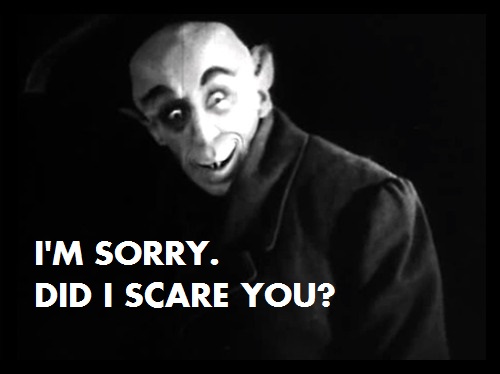As I noted in my previous post, the problem of a horror-themed storyworld is that the world must contain numerous potential stories, but with each story the audience consumes, the more the audience knows — and the more they know, the less frightening the subsequent stories become.
A great example of this is Lovecraft’s Cthulhu mythos, and specifically the Call of Cthulhu roleplaying game that’s based on it. It’s hard to find players who won’t come to the game with at least a passing knowledge of Cthulhu, Hastur, Azathoth, and their minions. It’s easy for such a player to let the air out of the story by saying something like, “Wet footprints in the museum? Stolen Innsmouth artifacts? We’re up against Deep Ones here, folks, so get your guns out and look for anyone who smells like fish.”
There are at least three ways to address this problem (I’m sure there are more, and I’d love to hear about them from you in the comments or on Twitter.) which I’ve called Go Hide, Go Big, and Go Small.
Go Hide
This is the most obvious solution: keep the characters (and by extension, the audience) in the dark as much as possible for as long as possible. Even when they come out the far side of a horror story, they’re not sure what just happened. By hiding the true, horrific nature of the world, you keep them ignorant, and therefore powerless and scared.
I’ve got a couple problems with this solution. For one thing, you’re just prolonging the inevitable; when the audience eventually figures out the horror elements, the jig is up. For another, you run a greater risk of annoying, rather than frightening or engaging your audience (a little mystery is fun; too much is frustrating).
Nevertheless, if your project calls for a short-lived storyworld (like for an ARG or a fiction anthology), this might be the best solution. There’s something to be said for keeping it simple.
Go Big
The key to this solution is to expand the world with each story, so that what the audience learns from one story doesn’t take the suspense out of another story; each story adds more mystery even as it reveals previous mysteries. This works especially well in storyworlds with serial stories, such as TV shows likes X-Files, LOST, or Supernatural. (I’m sure there’s a horror books series I should be listing here too, but I’m drawing a blank.)
One downside of this plan is that it’s terrible for non-serial stories. If you watch LOST episodes out of order, the later episodes totally spoil all the horror and suspense of the earlier ones. Another drawback is that by constantly expanding the world in order to keep some of it mysterious, you inevitably create a dense mythology (that can make your world inaccessible) and risk that your revealed mysteries aren’t as satisfying as the audience was hoping for. (See the last few seasons of LOST for examples of both these things.)
Go Small
In this solution, the true horror is in the specifics of each story. So while the audience may know, from previous stories, the secrets of the horror in general, they don’t know the secrets of this horror in this story. For example, someone playing a Ghost Punchers adventure might come into it knowing the mechanics and metaphysics of ghosts, but he can still be frightened by a hidden room full of blank-faced dolls in a daycare where several children have gone missing. Clearly the dolls and disappearances have something to do with ghosts, but what? And why are the dolls suddenly pointing at me and chanting my name?
This is the most versatile solution, and the one I like the best. Versatility is the key to great storyworld because it allows the most different types of stories. Going small doesn’t force your stories to hide big secrets from the audience or require your audience to consume them in sequence. You can add those things, but they are spice, not the main course.
Wrapping it up
Let’s see if I can summarize all three posts here…
- Horror comes from powerlessness.
- Powerlessness come from ignorance.
- To keep your horror storyworld scary, you need to keep your audience ignorant long enough to be frightened, but not so long they get frustrated and walk away.


Good read.
I’d counter that powerlessness does not always come from ignorance. Knowing a giant boulder is about to crush your car can be far worse than it simply hitting your car unannounced. Foreshadowing events (or even revealing certain elements completely) can build tension which, in turn, heightens the horror.
Great points! There’s a lot to be said for the power of foreshadowing.